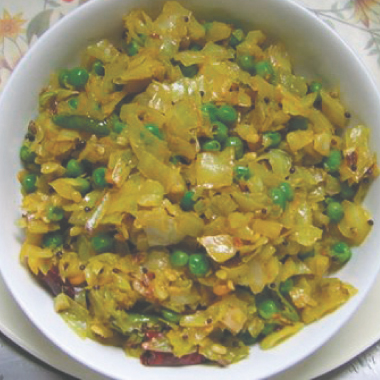Mama’s Punjabi Recipes – Band Gobi Aur Mutter ki Sabzi (Sauteed Cabbage & Peas)
Cabbage is a vegetable that is both quite inexpensive and has a lot of volume when cooked, which explains why it is so popular worldwide among the working class. It is a hardy vegetable that is closely related to broccoli, cauliflower and Brussels sprouts and grows in medium temperature in nitrogen rich soil, though some varieties grow in colder regions.
Cabbage has been cultivated for over 2,500 years and cabbage dishes are made all over the world. The Chinese pickle it; in Eastern Europe it is often boiled and cooked with meats; the Germans make sauerkraut from it and in the US, the most common use is making cole slaw served with barbeque. There are several types of cabbages available, but the most common are the purple and the green ones. The red one is best eaten pickled – I will provide the recipe later.
In India, cabbage is called band gobi or closed flower as opposed to phul gobi (literally open flower) for cauliflower. Although not as nutty flavored as cauliflower, cabbage is rich in vitamins K, C and Riboflavin as well as calcium and phosphorus. It helps clear the waste from the stomach, improves digestion and reduces constipation. In home remedies, cabbage is believed to help relief many ailments like warts, pneumonia, appendicitis and ulcers.
Many people do not like the taste of band gobi but when cooked with peas and/or waddian (dried lentil dumplings), this Punjabi dish is quite flavorful and I’m sure you will start to appreciate cabbage. The soft stalk, when peeled can even be eaten raw or chopped into a salad.
Ingredients:
I medium size green band gobi (cabbage)
1.5 cups of frozen mutter (peas)
2 tbsp tael (olive oil or vegetable oil)
1 tsp sarson ke til (mustard seed)
½ tsp haldi (turmeric powder)
Spices to taste: 1 tsp namak (salt), 1 tsp mirch (red pepper), ½ tsp garam masala
Directions:
1. Cut off the any shredded or wilted leaves and then cut the head into four quarters. Now chop the quarters into smaller 1.5 inch pieces. Cut out the hard center spine of the leaves and throw them away as they do not cook well.
2. Place the copped cabbage in a strainer and wash it in cold water and let it sit and drain for a while.
3. Warm the oil in a karai or wok over medium heat and add the turmeric and mustard seeds. When slightly roasted, throw in the chopped cabbage and mix well. Add the salt and pepper, stir, then cover and let it cook in its own steam for 10 minutes, stirring occasionally.
4. Reduce the heat to low, remove the cover and check if the cabbage has become tender and is not crunchy. Now add the peas, mix and cover again for 5 minutes.
5. Check if there is any water in the dish; if there is, then remove the cover and let the dish cook, stirring so that it does not stick. When there is no more water and the cabbage is tender, turn the heat off and let it sit half-covered for ten minutes.
6. Sprinkle with the garam masala before serving. This dish goes well with hot rotis or rice.
Shakuntla Malhotra is a skilled cook of Punjabi dishes made in the old-fashioned style that she learnt as a young woman in her ancestral home in Lyallpur, India before it became part of Pakistan after the Partition in 1947. People have often admired her cooking for its simplicity and taste that comes with each mouthful. Even in her mid-eighties, she continues to cook daily and agreed to share some of her delectable Punjabi recipes.


